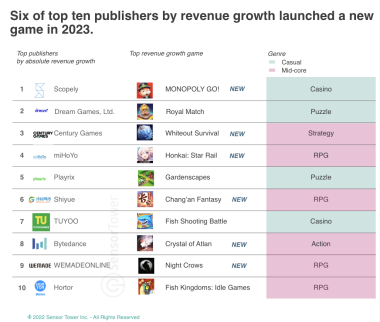Introduction
Mobile gaming has become one of the most popular forms of entertainment across the globe. With the advent of smartphones and tablets, mobile gaming has become more accessible than ever before. According to Statista, the global mobile gaming market was worth $68.5 billion in 2019 and is projected to reach $150.8 billion by 2023. In this article, we will take a deep dive into the mobile gaming market, its trends, projections, and the different characteristics of international markets from country to country.
Market Size of Mobile Gaming
The mobile gaming market has grown exponentially in recent years, with the number of smartphone users increasing worldwide. According to a report by Newzoo, there were 2.7 billion smartphone users worldwide in 2020, and this number is projected to reach 3.8 billion by 2021. As a result, the mobile gaming market is expected to continue to grow in the coming years.
According to Statista, the global mobile gaming market was worth $68.5 billion in 2019. In 2020, the market was worth $77.2 billion, and it is projected to reach $150.8 billion by 2023. The Asia-Pacific region is the largest market for mobile gaming, accounting for 47% of the global market in 2020. North America and Europe are the second and third-largest markets, accounting for 26% and 20% of the global market, respectively.
Characteristics of International Markets
The characteristics of international markets for mobile gaming vary from country to country. Each market has its unique features, such as demographics, culture, and mobile gaming preferences.
Asia-Pacific
The Asia-Pacific region is the largest market for mobile gaming, accounting for 47% of the global market in 2020. The region is dominated by China, which is the largest mobile gaming market in the world. Other major markets in the region include Japan, South Korea, and India.
China has the largest mobile gaming market globally, accounting for 29% of the global market in 2020. The country has a massive population and a large number of smartphone users, making it an attractive market for mobile game developers. However, the Chinese mobile gaming market is highly regulated, and game developers must obtain approval from the government before launching their games.
Japan is another significant market for mobile gaming, accounting for 9% of the global market in 2020. The country has a large population of mobile gamers, with many players preferring role-playing games (RPGs) and social casino games.
South Korea is another important market for mobile gaming, accounting for 4% of the global market in 2020. The country has a highly developed mobile gaming industry, with many popular games originating from South Korea. The country also has a large population of esports enthusiasts.
India is an emerging market for mobile gaming, accounting for 3% of the global market in 2020. The country has a massive population of smartphone users, making it an attractive market for mobile game developers. The most popular genres of mobile games in India are casual and arcade games.
North America
North America is the second-largest market for mobile gaming, accounting for 26% of the global market in 2020. The United States is the largest market in the region, accounting for 20% of the global market in 2020.
The United States has a highly developed mobile gaming industry, with many popular games originating from the country. The most popular genres of mobile games in the United States are puzzle, strategy, and sports games.
Europe
Europe is the third-largest market for mobile gaming, accounting for 20% of the global market in 2020. The United Kingdom is the largest market in the region, accounting for 4%
of the global market in 2020.
The mobile gaming market in Europe is diverse, with different countries having unique preferences for mobile games. For example, Germany has a large population of mobile gamers who prefer simulation and strategy games, while France has a large population of mobile gamers who prefer casual and puzzle games.
Latin America
Latin America is an emerging market for mobile gaming, accounting for 4% of the global market in 2020. Brazil is the largest market in the region, accounting for 2% of the global market in 2020.
Mobile gaming in Latin America is growing rapidly, driven by the increasing number of smartphone users in the region. The most popular genres of mobile games in Latin America are casual, arcade, and sports games.
Middle East and Africa
The Middle East and Africa is an emerging market for mobile gaming, accounting for 2% of the global market in 2020. Saudi Arabia and South Africa are the largest markets in the region, accounting for 1% of the global market each.
Mobile gaming in the Middle East and Africa is growing rapidly, driven by the increasing number of smartphone users in the region. The most popular genres of mobile games in the Middle East and Africa are puzzle, casual, and arcade games.
Trends in Mobile Game Development
- Cross-Platform Gaming: With the increasing popularity of mobile gaming, developers are creating cross-platform games that can be played on multiple devices, including mobile, PC, and consoles. This trend is expected to continue in the coming years, as more players prefer to play games on multiple devices.
- Augmented Reality: Augmented reality (AR) is becoming increasingly popular in mobile game development. Games such as Pokemon Go and Harry Potter: Wizards Unite have demonstrated the potential of AR in mobile gaming, and more games are expected to incorporate this technology in the future.
- Cloud Gaming: Cloud gaming allows players to play games on remote servers, eliminating the need for high-end devices. This technology is still in its early stages, but it is expected to grow in popularity in the coming years.
- Esports: Esports is a growing trend in mobile gaming, with many popular games such as PUBG Mobile and Call of Duty Mobile having their own esports tournaments. The esports market is expected to continue to grow, and more mobile games are expected to incorporate esports features.
- Subscription-Based Gaming: Subscription-based gaming is becoming increasingly popular, with games such as Apple Arcade and Google Play Pass offering a large selection of games for a monthly subscription fee. This trend is expected to continue, as more players prefer to pay a monthly fee for access to a large library of games.
- Social Gaming: Social gaming is becoming increasingly popular, with games such as Among Us and Fortnite allowing players to play with friends and other players from around the world. This trend is expected to continue, as more players prefer to play games with their friends.
- In-Game Advertising: In-game advertising is becoming increasingly popular, with many mobile games offering ads in exchange for in-game rewards. This trend is expected to continue, as more developers look for ways to monetize their games.
- Mobile Game Streaming: Mobile game streaming is becoming increasingly popular, with platforms such as Twitch and YouTube Gaming offering players the ability to stream their mobile games. This trend is expected to continue, as more players look for ways to share their gaming experiences with others.
- Personalization: Personalization is becoming increasingly important in mobile game development, with games offering players the ability to customize their characters and game environments. This trend is expected to continue, as more players look for ways to make their gaming experience unique.
- Monetization: Monetization is becoming increasingly important in mobile game development, with developers looking for ways to monetize their games without disrupting the player experience. This trend is expected to continue, with more developers exploring new ways to monetize their games, such as in-game purchases and in-game currency.
User Acquisition in Mobile Game Development
User acquisition is an important aspect of mobile game development, as developers need to attract players to their games to make them successful. Here are some key user acquisition trends in mobile game development:
- App Store Optimization: App Store Optimization (ASO) is becoming increasingly important in mobile game development, as developers need to optimize their app store listings to attract more users. ASO includes factors such as keywords, app descriptions, and user reviews.
- Influencer Marketing: Influencer marketing is becoming increasingly popular in mobile game development, with developers partnering with popular influencers to promote their games. Influencers can help attract new users to a game and increase its visibility.
- Social Media Marketing: Social media marketing is becoming increasingly important in mobile game development, with developers using platforms such as Facebook and Instagram to promote their games. Social media marketing can help increase the visibility of a game and attract new users.
- User Retention: User retention is becoming increasingly important in mobile game development, as developers need to keep players engaged with their games to make them successful. This includes factors such as game updates, new content, and in-game events.
- User Reviews: User reviews are becoming increasingly important in mobile game development, as they can influence a game’s visibility and popularity. Developers need to encourage positive user reviews and address negative reviews to maintain a positive reputation.
Projections for the Future
The mobile gaming market is expected to continue to grow in the coming years, driven by factors such as the increasing number of smartphone users, the growing popularity of esports, and the emergence of new technologies such as cloud gaming and augmented reality. Here are some projections for the future of the mobile gaming market:
- Market Size: The global mobile gaming market is projected to reach $196 billion by 2025 and $250 billion by 2030.
- Asia-Pacific: The Asia-Pacific region is expected to continue to be the largest market for mobile gaming, accounting for more than 50% of the global market by 2025.
- North America: North America is expected to remain the second-largest market for mobile gaming, accounting for around 25% of the global market by 2025.
- Europe: Europe is expected to remain the third-largest market for mobile gaming, accounting for around 20% of the global market by 2025.
- Latin America: Latin America is expected to be the fastest-growing market for mobile gaming, with a projected growth rate of 16% between 2020 and 2025.
- Middle East and Africa: The Middle East and Africa is expected to be an emerging market for mobile gaming, with a projected growth rate of 12% between 2020 and 2025.
Conclusion
The mobile gaming market is a rapidly growing industry that is expected to continue to grow in the coming years. With the increasing number of smartphone users, the emergence of new technologies, and the growing popularity of esports, mobile gaming has become a popular form of entertainment across the globe. Developers need to keep up with the latest trends in mobile game development and user acquisition to make their games successful. As the mobile gaming market continues to grow, there will be many opportunities for developers to create innovative and engaging games that attract new users and keep existing users engaged.





